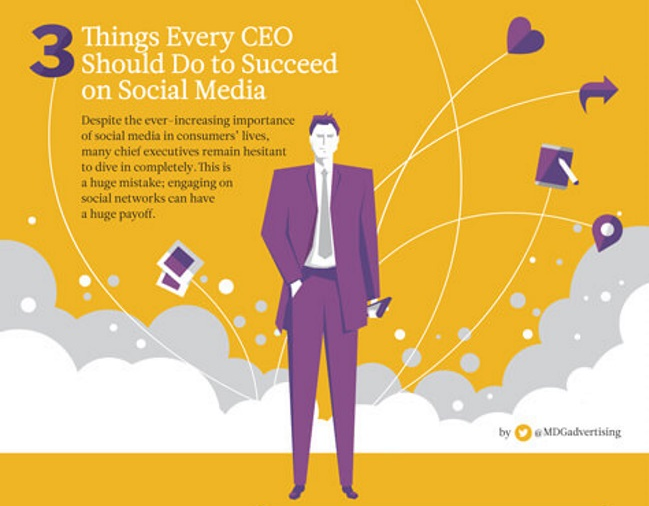Did you know that only one in three Fortune 500 CEOs have an active LinkedIn account, yet 75% of senior managers believe it’s a good idea for their CEO to be on social media? A new infographic from MDG Advertising takes a look at some of the pain points that are keeping CEOs off social media. If you’re an executive who’s thinking about jumping into the social media game – or if you’re trying to persuade one – this is a must-read.
The 3 Steps to Becoming a Social CEO
MDG’s research suggests these three steps are key for transitioning from a silent to a social CEO:
- Begin with LinkedIn.
- Pick other networks that you can commit to. You don’t have to be everywhere (you shouldn’t). But you do need to be present and active wherever you choose to establish yourself.
- Don’t be boring. (Tips on this below!)
#1 CEOs on LinkedIn
70% of CEOs who are active on just one social network are on LinkedIn, which makes it the most popular social network for CEOs. Assuming you already have a profile, make sure it’s optimized with a good headshot and full work history. Spend just a few minutes every other day, or as your schedule allows, to regularly like, comment, re-share and engage with other’s content. Try to publish something at least once a week, whether that’s a full blog post or just a few brief thoughts.
#2 Committing to Other Social Networks
Of the Fortune 500 CEOs on social media, 57 post publicly to Twitter, 57 are active on Facebook and two post to YouTube. Twitter offers some great opportunities for business leaders. However, YouTube, Facebook Live, and other video-rich platforms present easier, faster, and more rewarding communications opportunities. MDG suggests picking an additional network based on…
- Your audience demographic
- Your audience’s behavior on social
- Your preference and your audience’s preference for visual v. text
- Your ability to respond and engage. For example: a faster response will be expected on Twitter, while a slower response is fine for YouTube.
#3 Keeping It Interesting
Think that a professional status means you have to keep a dry online presence? Not at all. This is one of the themes I tackle in my latest book, Finally Human. For an example of how “professionalism” doesn’t equal boring, just take a look at how this Texas Supreme Court Justice uses Twitter. To keep it interesting on social, share bold ideas, display your personality, and give up on perfectionism! Also, realize that the majority of CEOs are likely enlisting at least some professional help in creating and publishing content.
Check out the full infographic below…
How to Be a Social CEO

